Heart: AKA the fire pump
Imagine you are given a family heirloom that cannot be replaced, like an old fire truck that you can’t get parts for any more. Once it’s damaged it’s damaged for life. It must be maintained but needs to be used in order to keep it from rusting and seizing up. Your heart is like that fire truck only the damage done by neglect is not so easily seen and can even be fatal without any warning.
That fire truck is required to push water (blood) from the tip of your toes to the top of head and everything in between. The blood flows through hose lines (arteries and veins) and if it isn't being pushed well enough or the hose lines have some damage, then you may suffer serious complications or even worse, a limp hose!
Occasionally you get a warning your heart isn't working so well. A bad sign that should be checked out by a doctor immediately is when you’re carrying the chief’s donuts (brown nose flavour) up two flights of stairs and you become out of breath or have chest pain. While on medical calls for possible cardiac arrest we often arrive before the ambulance. If the patients are still alive, they are pale, sweating, suffering arm or chest pain and have a look of panic in their eyes (50% die without these warning signs). Their families standing around them are panicked as well. To reduce the chance of this experience happening to us we can do something about it by the choices we make everyday such as exercising and eating well. As fire fighters we should take note when on these calls. Of the 100 plus fire fighter on-duty fatalities each year, approximately 50% die this way. Fire scenes are physically and mentally stressful which leads to high body temperatures and dehydration that stresses our hearts even more.
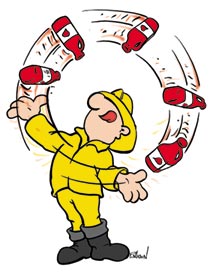 So how hard does our heart work? Take five bags of milk and start juggling (that is about the amount of blood in a body) and do that 24 hrs a day for about 365 days.
You get the exhausting picture of what the fire pump in your chest has to do. It pushes that blood through hose lines (arteries and veins) that if kept flexible and elastic, will assist making the pump (heart) work much easier. That pump must be ready to fill a child’s small pool then switch into high gear in a moment’s notice to put out a huge fire. All the while, the heart must send little hose lines to the pump itself, bringing fresh oxygenated blood to keep it running.
So how hard does our heart work? Take five bags of milk and start juggling (that is about the amount of blood in a body) and do that 24 hrs a day for about 365 days.
You get the exhausting picture of what the fire pump in your chest has to do. It pushes that blood through hose lines (arteries and veins) that if kept flexible and elastic, will assist making the pump (heart) work much easier. That pump must be ready to fill a child’s small pool then switch into high gear in a moment’s notice to put out a huge fire. All the while, the heart must send little hose lines to the pump itself, bringing fresh oxygenated blood to keep it running.
Now imagine there is some excitement in your life which triggers a second alarm blaze in your body (you are forced to run away from a vicious Dalmatian or better yet…the kids are with the grandparents!) and you call for your heart to pick up the pace a bit. If you’ve kept the heart parked and ignored it for a while, filling the fuel tank with fat and sugar instead of healthy high-octane fuel, you could be in trouble. The chief screams for more water (blood) but the pump is not able to push the amount needed. The pump is straining and the hose lines are not helping matters, as they are hardened by all the fatty, sugary foods clogging and sticking to the walls and scarring the lines. Meanwhile, the parts of the body needing the blood are only getting a small drip out the hose line.
 Now in real life that fire truck is worth a lot of money and would be maintained to extend its life to have it working in case of an emergency. So shouldn't you do the same to your body which is beyond a price tag? Ok, enough preaching lets see what your body is all about.
Now in real life that fire truck is worth a lot of money and would be maintained to extend its life to have it working in case of an emergency. So shouldn't you do the same to your body which is beyond a price tag? Ok, enough preaching lets see what your body is all about.
The heart is a muscle that beats to a different drum. It has an ability to keep its own beat and needs its own electrical system to pass messages to each cell. This coordination occurs by telling what area of the heart it should pump first as it is made of different chambers. This is like when the fire captain and his crew are in a fire and he radios his fire pump operator when they are in position with the hose. He tells the operator how much water to pump and his radio system better pass on the signal or they’re in trouble. Likewise, if you damage an area of the heart (even a small heart attack) scar tissue forms interfering with the passing of that message.
To picture how the heart works, imagine that the fire truck’s pump in your chest has four rooms with buckets inside of each room. Each room is manned by a fire fighter to pump the water (or blood in this case) out. Let’s first look at two of these rooms that are on top of one another. The top room is occupied by a fire fighter called (Mr. Right Atrium). He catches used blood from veins in the body that needs freshening up. To be efficient he shares the workload with a team to get it to the lungs and then back to the rest of the body. To do this, Mr. Right Atrium opens a flap on the bottom of the bucket and squeezes the bucket a bit to help drop the blood into the bottom bucket being held by a more muscular fire fighter (Mr. Right Ventricle).
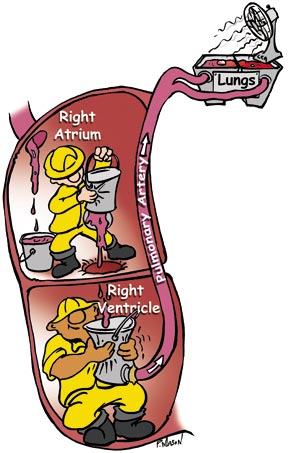 Fire fighter Right Ventricle then squeezes really hard to push the blood out of a hole in the bottom of that bucket that is attached to the pulmonary artery fire hose. The blood is then pushed by that squeeze though the fire hose to the lungs, picking up oxygen and then exiting the lungs all nice and fresh. The oxygenated blood is then forced into the top room of another set of chambers, similar to the first two but beside them on the left. (Remember when you are looking at the heart in someone else’s chest the left side will be on their right).
Fire fighter Right Ventricle then squeezes really hard to push the blood out of a hole in the bottom of that bucket that is attached to the pulmonary artery fire hose. The blood is then pushed by that squeeze though the fire hose to the lungs, picking up oxygen and then exiting the lungs all nice and fresh. The oxygenated blood is then forced into the top room of another set of chambers, similar to the first two but beside them on the left. (Remember when you are looking at the heart in someone else’s chest the left side will be on their right).
That new top bucket held by fire fighter (Mr. Left Atrium) is happy to get nice fresh, bright red, oxygenated blood. He then opens up a flap (valves) of his bucket and gives a little squeeze similar to the other side and dumps it down to the next bucket with the thickest (muscular) walls. It is held by the strongest pound for pound fire fighter in the station (Mr. Left Ventricle). His nickname at my station was “Popeye”. Now Mr. Left Ventricle has to use all the muscle that he has been training for all his life to get that blood though the thickest fire hose (the Aorta)in order to circulate blood from the tip of his toes to the top of his head.
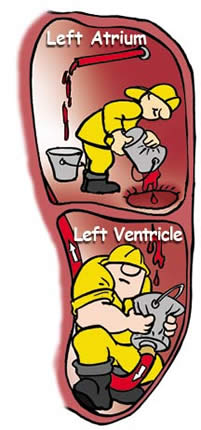 Blood then returns after being used by the body in thinner walled hoses called Veins. The used blood then goes into that original room we first talked about (Mr. Right Atrium) but now that blood is dark red and filled with waste products like carbon dioxide (CO2). This has to be brightened up with fresh air (O2) and so it goes through the cycle again causing the heart to beat at about 60-100 times a minute (more times if you’re out of shape and less times if in shape).
Blood then returns after being used by the body in thinner walled hoses called Veins. The used blood then goes into that original room we first talked about (Mr. Right Atrium) but now that blood is dark red and filled with waste products like carbon dioxide (CO2). This has to be brightened up with fresh air (O2) and so it goes through the cycle again causing the heart to beat at about 60-100 times a minute (more times if you’re out of shape and less times if in shape).
As was mentioned before our hose lines that carry the oxygenated blood to every tiny cell in your body can be damaged by intakes of saturated fats, trans fats, excess sugar, and nicotine from smoking or second hand smoke. High blood pressure that continuously pushes the wall of the hose outwards stresses the elasticity and looks for cracks to create bulges that can break. Even chronic inflammation can damage the inner hose line from conditions like, gum disease, stress and even sexually transmitted diseases (keep the fire hose protected at all times with a rubber fire coat)!
When you damage the hose lining (inner arterial wall) your body likes to put a patch on it called cholesterol. Cholesterol is very important to the normal functioning of the body; it is needed for steroids like testosterone, estrogen and cell development but too much of it can lead to trouble. There are two types of cholesterol, one a hero the other a louse. One is called HDL and the other LDL. THE “H” in HDL stands for High and Healthy and the “L” in LDL stands for Low and Lousy. This lousy cholesterol from saturated fats is easily available and therefore gets jammed into those damaged cracks of the hose inner lining.
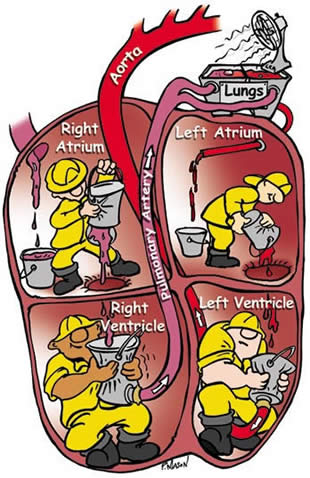 The body likes to send a fire truck mechanic named Nick the Greek to the affected site and when he sees the crappy job being done by the LDL, he gets all mad and inflamed. Fire mechanic Nick loves olive oil from Greece as it has plenty of the high and healthy HDL that helps to transport the lousy cholesterol out of the arteries. He knows the LDL comes from saturated fats (fats that stay solid at room temperature). It is found in butter and fats like red meat as well as in that bacon grease you just smeared on your non-nutritional white bread of death.
The body likes to send a fire truck mechanic named Nick the Greek to the affected site and when he sees the crappy job being done by the LDL, he gets all mad and inflamed. Fire mechanic Nick loves olive oil from Greece as it has plenty of the high and healthy HDL that helps to transport the lousy cholesterol out of the arteries. He knows the LDL comes from saturated fats (fats that stay solid at room temperature). It is found in butter and fats like red meat as well as in that bacon grease you just smeared on your non-nutritional white bread of death.
Now getting even angrier at how bad you are eating (burgers and fries for lunch), Nick gets out some foam and sprays it in the hose cracks, actually forming foam cells that attract platelets. It is now like a Greek wedding with a crazy amount of plates (platelets) being thrown at the cracks. They begin sticking to the lousy patchwork that was laid down in a hurry. These platelets are very important to the normal healing of wounds but in this case they break off and head down the hose line possibly clogging it.
If a chunk of this material gets into the lungs, heart or brain it can be lights out for good due to the blood flow being stopped (Heart Attack or Stroke). The troubling thing is that there is sometimes no evidence of this cholesterol damage so you need to get your oil levels checked!
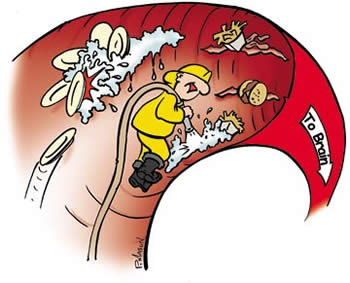 Remember those rooms on top of each other? Well the top room is called an atrium, which is fancy talk meaning “nice room to hang out in”. The blood hangs out until the ventricle (the bottom room) is ready to receive the blood. The top room/bucket has a flap on the bottom of it that when opened, allows the blood to go into the room below called a ventricle which literally wants to “vent” the blood flow. Those flaps are one-way valves that are only supposed to let the blood flow downwards. The opening and closing of the valves is what your doctor is listening for with a stethoscope.
Remember those rooms on top of each other? Well the top room is called an atrium, which is fancy talk meaning “nice room to hang out in”. The blood hangs out until the ventricle (the bottom room) is ready to receive the blood. The top room/bucket has a flap on the bottom of it that when opened, allows the blood to go into the room below called a ventricle which literally wants to “vent” the blood flow. Those flaps are one-way valves that are only supposed to let the blood flow downwards. The opening and closing of the valves is what your doctor is listening for with a stethoscope.
There is a noise in your heart caused by the slamming shut of the upper room’s bottom valves. This is due to pressure pushing up against the bottom of it by the ventricle below when it starts to contract and that is what the doctor hears. This is a “LUBB” sound. The heartbeat is actually two beats heard quickly together known as LUBB DUBB. If the valves between these two rooms are not working correctly, blood will flow back up into the upper room. When the blood goes backwards it decreases the heart’s efficiency and a swishing noise called a Murmur may be heard.
The second heart sound “DUBB” is the noise of the second room’s (Ventricle’s) bottom valve being slammed shut after it has finished squeezing. All the pressure leaves that ventricle, filling the hoses with the fresh blood. It is the backpressure from the expanding and contracting major fire hoses (pulmonary artery and aorta) that closes the bottom rooms valves. Put an ear to your favorite chest (with permission of course) and listen for the two sounds.
Exercise is one of the best ways to keep the heart young and healthy. Exercise for the heart isn’t about pounding nails on your days off to build your chief’s deck while he sips an umbrella drink. Don’t get me wrong, that is great physical work but you need to get the heart pumping a little more once in a while. The heart is designed to push hard for 20-30 minutes, a few times a week. Not only does exercise make the heart stronger and allow it beat less per minute (less juggling of those milk bags while resting) but it also lowers the lousy cholesterol and raises the healthy cholesterol. This will help keep those hose lines flexible and clog free.
Activities like biking (remember your helmet) and using elliptical trainers are awesome and can be easier on the joints than pavement pounding exercises (I miss running but my knees and back sure don’t). As one of my teachers, a medical doctor from India would say, "I feel sorry for people as they run, destroying their joints. If god had wanted man to run he would have made him a cheetah". In dissection class I was always amazed at how thin the joints cushioning protection was and how easily it can be damaged and worn away leaving nothing but bone riding on bone. It is the equivalent to not greasing the bearings in the fire trucks wheels and having the steel rub against steel, wearing them out quicker.
I started walking after back surgery as I was told the problem would be to keep the weight off during recovery. Walking was amazing and accelerated the healing process. I became aware of a whole secret society of walkers. They are everywhere and you can join them for the price of a comfy pair of shoes. That’s it! What I noticed about walkers is that they seemed to be very healthy, had a very pleasant attitude and acquired a sense of community that encouraged even more health. So now I take the stairs every chance I get and I park my car away further away from the grocery store door to keep up with my post surgery pace. The weight has stayed off and now I walk and jog a bit to get my heart rate up just enough to remind me why I don’t run. Afterwards I feel great without the wear and tear on the joints. It also reminds me that movement and being outdoors is important to my mental health as well.
Another heart-helper is to stop carrying around those extra pounds and I know this is a sensitive subject. The reality is that it takes a lot of hard work to carry around extra weight! Lift up a large water cooler bottle and carry that around all day and think how strong you would get. The problem is that the extra weight is tough on the body, wearing and tearing down the joints (knee, hip, back and ankle etc.) If that wear and tear on the body is weight from fat, the heart has to work even harder as each pound of fat is estimated to have a mile of extra blood vessels (hoses!) that the pump has to push blood through. So drop those pounds, as it’s less work to be lighter on the scales plus in the end you may save the expense and pain of joint replacement.
Extra weight is also directly linked to the spread of diabetes that is an epidemic sweeping across North America and affecting our children. Diabetes is responsible for damaging the hose lines (arteries). Other problems from Diabetes include kidney failure, blindness, leg amputations and even erectile dysfunction. So keep the simple sugars (soft drinks, cakes, cookies, fructose corn syrup, white bread) out of the lunch bag and replace it with low fat, low sugar snacks, whole grain breads and beverages like water.
It is also a good idea to keep stats on your body. There are guys in the fire hall that can tell you the top baseball teams from 1701 B.C., but they couldn't tell you their blood pressure and cholesterol levels. These are important numbers to know so create your own sports card and on the back put the date and your levels of a few simple tests. Get your blood pressure taken and do it few times over a few days and see if it rises during the day and by how much. Having too much pressure in your arteries is like over inflating the fire truck’s tires leading to a blow out or causing them to wear out too fast.
Blood pressure can be brought down with cardiovascular exercise, eating well and perhaps even through meditation or breathing exercises. Try this…take your pulse and then take it again after turning the lights off and closing your eyes. Take some deep relaxing breaths for 30-60 seconds while imagining taking it easy on a beach. Now take your pulse again and you should see a decrease. Do this often and you will get better at it, helping you live longer or at least mentally taking you back to Shangri-La and putting a smile on your face!
Your cholesterol levels need to be in check and you should have as high of an HDL (high and healthy) as you can get and on one end and as low of an LDL (low and lousy) on the other. As stated earlier, YOU can achieve this by exercising, eating good foods and staying away from deep fried foods and unhealthy snacks. Eat healthy foods like olive oil, low fat meats and nuts for protein and brown rice and bread that contains grains and feels heavy. Try eating dark green vegetables and add some colour with different types (orange vegetables, squashes etc) to get a good balance. The occasional glass of red wine (that was a glass, not a bottle) has also shown some cardiovascular benefits. Remember that a lot of alcohol causes inflammation and may inactivate your immune system. Not to mention it also decreases the risk of exercising!
So take it easy on the excuse “my doc says its ok to drink” because if you have a habit of one drink turning into a second and so on then maybe stick to grape juice as some studies say it is awesome for you as well.
So if you care for your heart like you do your fire truck make sure to get your oil levels checked, keep the hoses flexible and get your engine racing a few times a week. Cheers!
